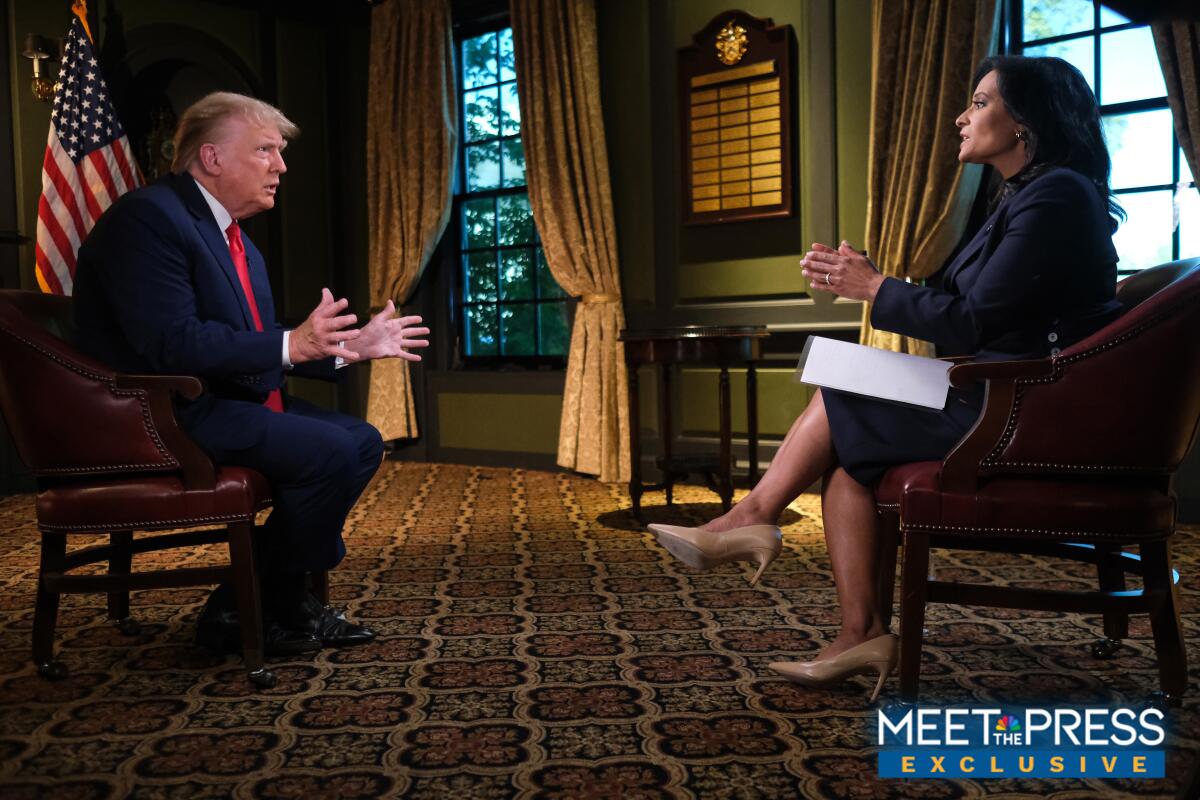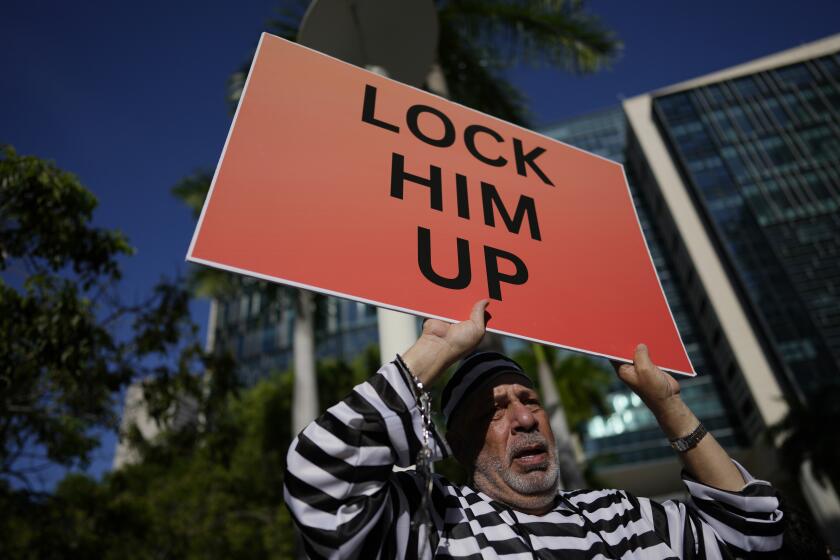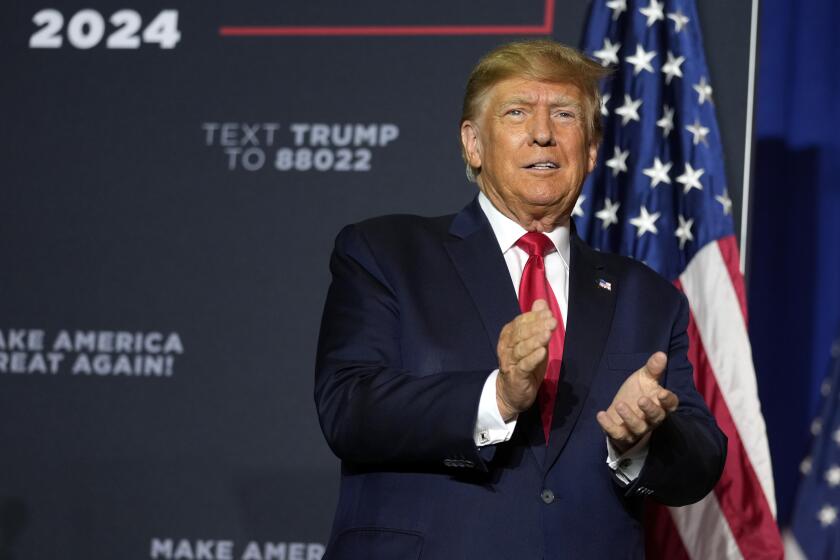Opinion: How not to cover Donald Trump’s bizarre 2024 campaign for president

- Share via
The press should borrow a lyric from “The Sound of Music” and ask itself: “How do you solve a problem like Donald?” Or, put another way, how should journalists cover Trump’s unprecedented campaign for president while under indictment for trying to overturn an election and more?
The question concerns not just Trump but also politics and campaigns more broadly in an age of fragmented media and polarized politics. The answer requires recognizing journalists’ altered role and fulfilling it with more care, preparation and diligence.
Many confronting the challenge of covering Trump conclude that, as a recent column in the Arizona Republic put it, “It’s time to stop giving Trump airtime.” The larger point is that the media shouldn’t give exposure to people they know are going to make provably false assertions.
The problem with the “Don’t amplify liars” argument is twofold. First, the press is no longer a gatekeeper of what people know; it’s more often an annotator of what they’ve already heard elsewhere. So not covering Trump, Rep. Marjorie Taylor Greene or others in politics who say patently false things will not silence them. It will just leave them less examined.
The amendment’s Section 3 bars officials who betray the government from holding office again. Trying to keep the elected president out of office by force counts by any standard.
Second, it’s a dereliction of the press’ duty to ignore powerful dissemblers and liars in public life. We have an obligation to explain what’s false and offer clear and persuasive evidence of the truth. We have to help the public understand.
How can the press do that? Let’s start with Kristen Welker’s much-criticized recent interview with Trump on NBC’s “Meet the Press.” The problem wasn’t that a reporter was interviewing Trump. The failures were in the execution.
The greatest failure was in not anticipating what Trump would predictably say and being prepared to follow up. Journalists tend to exaggerate the power of the “great question” and too often fail to develop strategies that lead to better answers. One reason so many politicians are having their way with reporters today is that they are better-prepared and better-versed in interview dynamics than the people interviewing them.
After a Times columnist faulted the media for its coverage of the Trump arraignment, readers share how they think journalists should talk about the ex-president.
This notion of mapping out a questioning strategy is Interviewing 101 for lawyers. Attorneys identify where they want to end up and work backward, developing a series of questions that will guide a dishonest witness to a place where their evasions are exposed. Journalists need to plan their interviews in the same way but too often don’t.
This strategy usually relies on specificity: asking an evasive subject to provide evidence of their false assertions and having evidence ready to contradict predictable falsehoods and exaggerations. Jonathan Swan, then of Axios, provided an apt example in a 2020 interview with Trump. When the then-president tried to flimflam him with misleading statistics at one point, Swan replied with precision, detail and follow-up.
“Oh, you’re doing death as a proportion of cases,” Swan told Trump. “I’m talking about death as a proportion of population. That’s where the U.S. is really bad — much worse than South Korea, Germany, etc.”
“You can’t do that,” Trump replied weakly.
“Why can’t I do that?” Swan retorted.
Donald Trump is an abnormal candidate who must not be normalized in some run-of-the-mill Q&A with voters. Can CNN avoid the media’s 2016 mistakes?
When journalists lack that level of preparation, they slide into a trap Welker fell into. She ended up in a debate with Trump, repeatedly insisting “That’s not true” but having nothing in hand to prove it.
In the end, such encounters between journalists and politicians almost never get a subject to admit they’re wrong. But a well-prepared interview strategy, with a line of questions pointing in a clear direction and backed by evidence, offers the public three tangible benefits: It creates clarity rather than confusion, reveals more about the politician and makes it harder to lie.
Even if the press is not interviewing Trump or another politician — such as Florida Gov. Ron DeSantis, who is too afraid to face reporters one on one — this strategy of having hard evidence ready and using it well has become essential to reporting on their statements and campaigns. Again, we are now annotators.
How should the press cover a modern campaign more generally? The answers here are not new or complicated. But they do require more discipline and enterprise than chasing the parade, a habit journalists too readily fall into.
The press should dramatically reduce the time it spends following candidates around and attending rallies, imagining that the way politicians run their campaigns is a proxy for how they would govern. This conventional approach inevitably leads to stories on campaign tactics and horse-race coverage. Most voters don’t care. The press does it because it’s easy.
The 2024 race will be nothing like what journalists have encountered in past elections. They would better serve the public if they changed their habits and shifted their resources to four other dimensions of the campaign.
The candidates’ biographies: The campaign biography should be a full-time beat, not a one-day story. Reporters should focus on telling us who the candidates are, what they have done, how they have led, the impact of their choices, how they treat other people and more. And modern storytelling forms can present this information more effectively and accessibly than the classic candidate biography.
The nation’s problems: Campaign coverage should focus more on the biggest problems facing the country, from inflation to climate change to the resilience of our democracy, and tell us what the candidates have done and can be expected to do about them. But these shouldn’t be old-fashioned compilations of shorthand policy positions that don’t mean much and falsely suggest every candidate is equally prepared for every challenge. If a candidate doesn’t really have a record on an issue or much apparent understanding of or interest in it, reporters need to make that clear.
Better fact-checking: Fact-checking needs to become a less haphazard and more relentless feature of political coverage. Traditional journalistic fact-checking is often too subjective: Journalists look for questionable statements to check out, inviting suspicion about bias. Beyond that traditional approach, fact-checkers should also borrow from social science by testing and measuring the veracity of random samples of statements, which would give voters more insight into the candidates’ truthfulness. Also, because research shows voters resist fact-checking of their favored candidates, fact-checkers should organize their work by issue as well as by politician, which would be more informative for more people.
The electorate: The press is supposed to operate in the name of the people, but too often its work reduces the public to a bystander. It should be a subject. Journalists should go beyond the usual polls and Midwestern diner interviews to report more deeply and consistently on what people across the country are feeling and thinking.
At bottom, elections are moments of public self-reflection. They tell us how we, the people, feel about the country and our future. If, on election day, the result seems inexplicable, that is a failure of journalism.
Tom Rosenstiel is a professor at the University of Maryland’s Philip Merrill College of Journalism and a former media writer for the Los Angeles Times.
More to Read
A cure for the common opinion
Get thought-provoking perspectives with our weekly newsletter.
You may occasionally receive promotional content from the Los Angeles Times.













